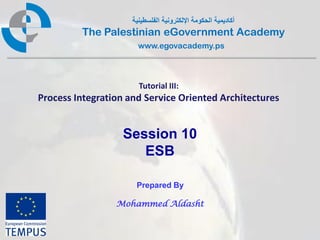The document provides an overview of the Microsoft BizTalk Server, an enterprise service bus (ESB) product. It describes BizTalk's architecture as being built on a publish/subscribe model with messages published to BizTalk, transformed, and routed to subscribers. It stores messages in a database while waiting for external events to prevent data loss. BizTalk's messaging engine enables processes across multiple applications through specifying process logic and communication mechanisms. It uses send/receive adapters and pipelines to communicate with external applications, and implements orchestrations as executable business process logic code.






![Introduction
• Using point-to-point
integration approach leads
to unreliable, insecure,
non-monitorable and in
general non-manageable
communication channels
between applications.
• Process logic and data
transformation logic is
encoded into the
applications.
Tightly-coupled applications, Source [6]](https://image.slidesharecdn.com/palgov-tutorial3-session9-esb-120601115719-phpapp01/85/Pal-gov-tutorial3-session9-esb-7-320.jpg)
![Introduction
• In an ESB architecture all
kinds of applications are
provided as business services
and connected via reliable,
secure and manageable
virtual channels.
• Process orchestration and
data transformation logic can
be moved to the bus
• Process interactions can be
performed in a controlled
manner
• The ESB is an innovative
approach to enterprise
Integrate all kinds of applications using
application integration (EAI) a centralized EAI broker, Source [6]](https://image.slidesharecdn.com/palgov-tutorial3-session9-esb-120601115719-phpapp01/85/Pal-gov-tutorial3-session9-esb-8-320.jpg)
![Introduction: definitions
• The ESB is a new approach to integration that supports a
loosely coupled, highly distributed integration network [1].
– Shortly, a standards-based integration platform
• Also, we can say that an ESB is a flexible connectivity
infrastructure for integrating applications and services [4].](https://image.slidesharecdn.com/palgov-tutorial3-session9-esb-120601115719-phpapp01/85/Pal-gov-tutorial3-session9-esb-9-320.jpg)
![ESB 4 functions [4]
• An ESB performs the following between requestor
and service:
– Routing messages between services.
– Converting transport protocols between requestor and
service.
– Transforming message format between requestor and
service.
– Handling business events between different sources.](https://image.slidesharecdn.com/palgov-tutorial3-session9-esb-120601115719-phpapp01/85/Pal-gov-tutorial3-session9-esb-10-320.jpg)






![ESB forms a pervasive grid that can span a global enterprise network, Source [5]](https://image.slidesharecdn.com/palgov-tutorial3-session9-esb-120601115719-phpapp01/85/Pal-gov-tutorial3-session9-esb-17-320.jpg)
![Some ESB Characteristics
• Standards-Based Integration [1].
– ESB can utilize J2EE components for connectivity.
– ESB also integrates with applications built with .NET, COM, C#, and
C/C++.
– Can easily integrate with anything that supports SOAP and web-
services APIs.
• Distributed Data Transformation.
– Transformation services can be located anywhere and accessible from
anywhere on the bus
• Remote Configuration and Management.
– Local IT staff can't always be at each remote location](https://image.slidesharecdn.com/palgov-tutorial3-session9-esb-120601115719-phpapp01/85/Pal-gov-tutorial3-session9-esb-18-320.jpg)

![ESB Components
3 key components of an ESB architecture: MOM, Service container, and Management facility, Source [5]](https://image.slidesharecdn.com/palgov-tutorial3-session9-esb-120601115719-phpapp01/85/Pal-gov-tutorial3-session9-esb-20-320.jpg)
![Message Oriented Middleware (MOM)
• A MOM is a key part of the ESB architecture [1].
– It provides a network of virtual channels that an ESB uses to
route messages throughout an enterprise and beyond.
• In a MOM-based communication environment,
messages are usually sent and received asynchronously
• MOM in combination with message queues are
fundamental components of the ESB](https://image.slidesharecdn.com/palgov-tutorial3-session9-esb-120601115719-phpapp01/85/Pal-gov-tutorial3-session9-esb-21-320.jpg)
![Message Oriented Middleware
Source, [1]](https://image.slidesharecdn.com/palgov-tutorial3-session9-esb-120601115719-phpapp01/85/Pal-gov-tutorial3-session9-esb-22-320.jpg)
![Tightly Coupled Versus Loosely Coupled
Interfaces
• Synchronous RPC-Style Programming [1]:
– Technologies that predominantly use RPC-style communication include:
CORBA, RMI, DCOM, Sun-RPC, Java API for XML-RPC (JAX-RPC)
– Synchronous RPC-based interactions consist of multiple point-to-point
integrations that depend on each other.
– Minimum number of application interfaces is n(n-1)/2
• Asynchronous message-based interfaces are much more loosely
coupled and manageable](https://image.slidesharecdn.com/palgov-tutorial3-session9-esb-120601115719-phpapp01/85/Pal-gov-tutorial3-session9-esb-23-320.jpg)
![Where MOM fits?
The shift from synchronous remote calls to asynchronous message exchange, Source [5]](https://image.slidesharecdn.com/palgov-tutorial3-session9-esb-120601115719-phpapp01/85/Pal-gov-tutorial3-session9-esb-24-320.jpg)
![Asynchronous Messaging Models
Point-to-point and publish-subscribe messaging models, Source [5].](https://image.slidesharecdn.com/palgov-tutorial3-session9-esb-120601115719-phpapp01/85/Pal-gov-tutorial3-session9-esb-25-320.jpg)
![Service Container
Connecting services to the ESB using ESB endpoints that are managed by a service
container, Source [5]](https://image.slidesharecdn.com/palgov-tutorial3-session9-esb-120601115719-phpapp01/85/Pal-gov-tutorial3-session9-esb-26-320.jpg)








![An ESB itinerary represents a distributed
business process
Source, [1]](https://image.slidesharecdn.com/palgov-tutorial3-session9-esb-120601115719-phpapp01/85/Pal-gov-tutorial3-session9-esb-35-320.jpg)
![Itinerary-based routing in an ESB
Source, [5]](https://image.slidesharecdn.com/palgov-tutorial3-session9-esb-120601115719-phpapp01/85/Pal-gov-tutorial3-session9-esb-36-320.jpg)

![Service orchestration using BPEL
Source, [5]](https://image.slidesharecdn.com/palgov-tutorial3-session9-esb-120601115719-phpapp01/85/Pal-gov-tutorial3-session9-esb-38-320.jpg)

![Content-based routing in an ESB
Source, [5]](https://image.slidesharecdn.com/palgov-tutorial3-session9-esb-120601115719-phpapp01/85/Pal-gov-tutorial3-session9-esb-40-320.jpg)










